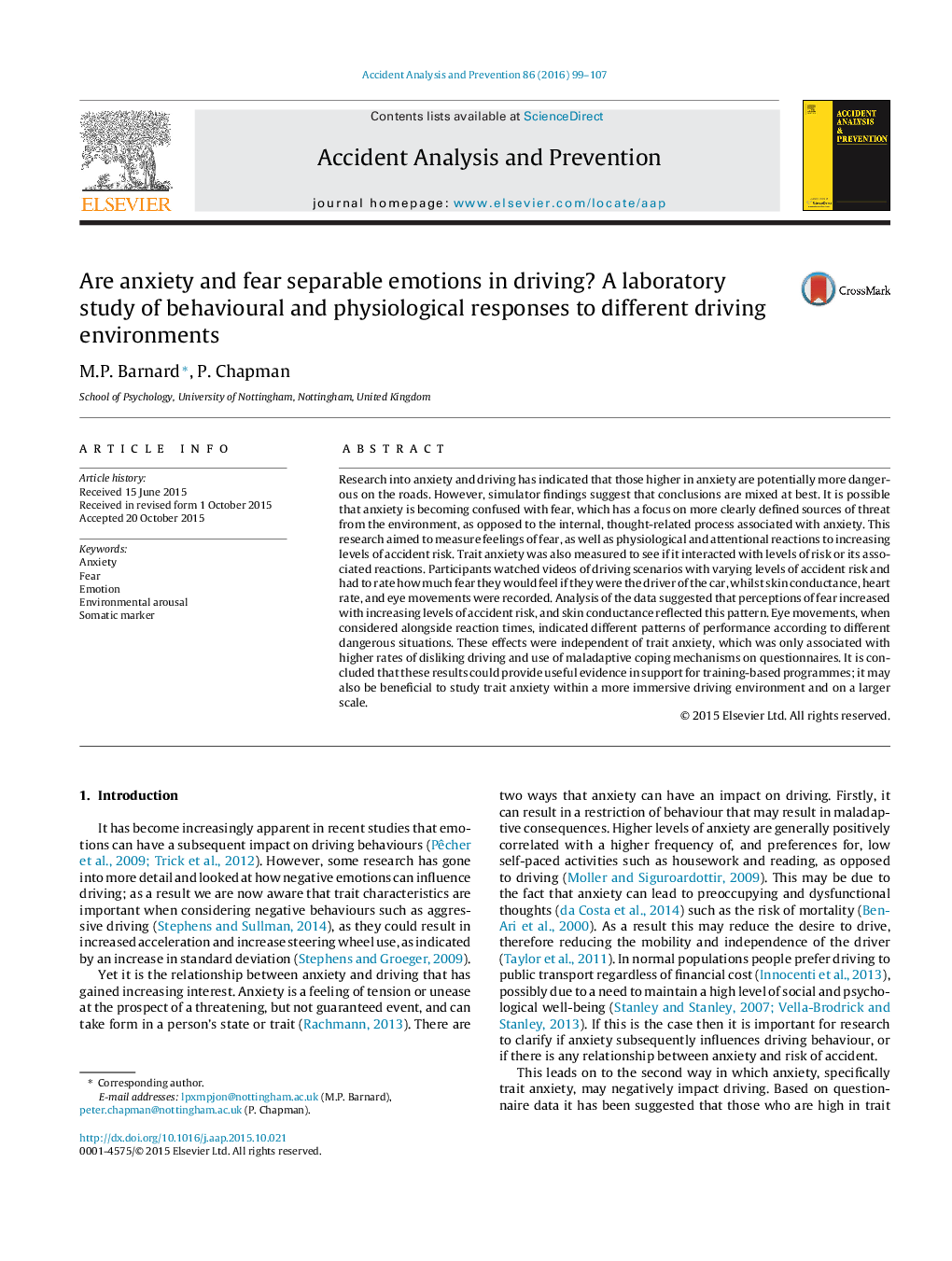| کد مقاله | کد نشریه | سال انتشار | مقاله انگلیسی | نسخه تمام متن |
|---|---|---|---|---|
| 6965409 | 1452911 | 2016 | 9 صفحه PDF | دانلود رایگان |
عنوان انگلیسی مقاله ISI
Are anxiety and fear separable emotions in driving? A laboratory study of behavioural and physiological responses to different driving environments
ترجمه فارسی عنوان
آیا اضطراب و ترس احساسات جداگانه در رانندگی وجود دارد؟ مطالعه آزمایشگاهی پاسخ های رفتاری و فیزیولوژیکی به محیط های مختلف رانندگی
دانلود مقاله + سفارش ترجمه
دانلود مقاله ISI انگلیسی
رایگان برای ایرانیان
کلمات کلیدی
اضطراب، ترس هیجانی، تحریک محیط زیست، نشانه سوماتیک،
ترجمه چکیده
تحقیقات در مورد اضطراب و رانندگی نشان داده است که کسانی که اضطراب بالاتری دارند در جاده ها بالقوه خطرناک تر هستند. با این حال، یافته های شبیه ساز نشان می دهد که نتیجه گیری در بهترین حالت مخلوط می شود. ممکن است که اضطراب با ترس اشتباه گرفته شود، که بر منابع بیشتر تهدید از محیط زیست متمرکز است، در مقایسه با روند درونی و فکری مرتبط با اضطراب. این پژوهش با هدف سنجش احساسات ترس و همچنین واکنش های فیزیولوژیکی و توجه به افزایش سطوح خطر تصادف است. اضطراب قلبی نیز اندازه گیری شد تا ببیند آیا با سطوح خطر یا واکنش های مرتبط با آن ارتباط برقرار می کند. شرکت کنندگان فیلم هایی از سناریوهای رانندگی با سطوح مختلف ریسک تصادف را تماشا کردند و باید میزان ترس آنها را در صورت رانندگی ماشین احساس کنند، در حالی که میزان هدایت پوست، ضربان قلب و حرکات چشم ثبت شد. تجزیه و تحلیل داده ها نشان می دهد که ادراک از ترس با افزایش سطح خطر تصادف افزایش می یابد و هدایت پوست این الگوی را منعکس می کند. حرکات چشم، زمانی که در کنار زمان واکنش در نظر گرفته می شوند، الگوهای متفاوت عملکرد را با توجه به موقعیت های مختلف خطرناک نشان می دهند. این اثرات مستقل از اضطراب روانی بود که تنها با ریسک بالای رانندگی غیرمجاز و استفاده از مکانیسم های مقابله ناسازگار در پرسشنامه ارتباط داشت. نتیجه گیری می شود که این نتایج می تواند شواهد مفید در حمایت از برنامه های آموزش مبتنی بر دانش ارائه دهد؛ همچنین ممکن است برای مطالعه اضطراب عاطفی در یک محیط رانندگی فراگیرتر و در مقیاس بزرگتر سودمند باشد.
موضوعات مرتبط
مهندسی و علوم پایه
مهندسی شیمی
بهداشت و امنیت شیمی
چکیده انگلیسی
Research into anxiety and driving has indicated that those higher in anxiety are potentially more dangerous on the roads. However, simulator findings suggest that conclusions are mixed at best. It is possible that anxiety is becoming confused with fear, which has a focus on more clearly defined sources of threat from the environment, as opposed to the internal, thought-related process associated with anxiety. This research aimed to measure feelings of fear, as well as physiological and attentional reactions to increasing levels of accident risk. Trait anxiety was also measured to see if it interacted with levels of risk or its associated reactions. Participants watched videos of driving scenarios with varying levels of accident risk and had to rate how much fear they would feel if they were the driver of the car, whilst skin conductance, heart rate, and eye movements were recorded. Analysis of the data suggested that perceptions of fear increased with increasing levels of accident risk, and skin conductance reflected this pattern. Eye movements, when considered alongside reaction times, indicated different patterns of performance according to different dangerous situations. These effects were independent of trait anxiety, which was only associated with higher rates of disliking driving and use of maladaptive coping mechanisms on questionnaires. It is concluded that these results could provide useful evidence in support for training-based programmes; it may also be beneficial to study trait anxiety within a more immersive driving environment and on a larger scale.
ناشر
Database: Elsevier - ScienceDirect (ساینس دایرکت)
Journal: Accident Analysis & Prevention - Volume 86, January 2016, Pages 99-107
Journal: Accident Analysis & Prevention - Volume 86, January 2016, Pages 99-107
نویسندگان
M.P. Barnard, P. Chapman,
